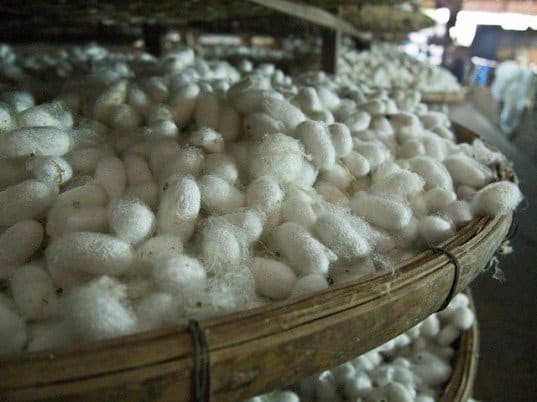We all like feeling warm during the winter and cool during the summer, which is exactly how it feels when you wear silk.
Research scientists at the Air Force Research Laboratory (AFRL) and Purdue University in Indiana are attempting to make a synthetic silk. The goal is to develop a fiber that could be woven into a very strong yet flexible material. They would also have to find a way to produce large quantities of this textile using current production methods.
These scientists are studying the temperature regulation and cooling properties of natural silk. They are trying to find the source of these properties to duplicate in man-made fibers like artificial spider silk. In fact, artificial spider silk is stronger than Kevlar while having more flexibility than nylon.
Silk’s Cooling Properties
Silk gives off more heat when exposed to direct sunlight than it absorbs. This shows its passive radiative cooling qualities. On a hot day during the summer, silk will drop 10°-15°F when you compare it to materials with reflective properties. A fabric exhibiting these cooling properties would be of great benefit to soldiers if their body armor was made of such fabric.
Along with body armor, parachutes are also in line to be made from artificial spider silk. Existing body armor is way too heavy and made of non-breathable material. Parachutes made of artificial spider silk would be stronger, which means they’d be able to carry heavier payloads. Estimates are that artificial spider silk will be double the cost of Kevlar. However, its minimal weight, strength and elasticity mean there will potentially be many other applications, which will increase its saleability.
Enhancing the Comfort of Soldiers in Combat
One of the main goals of studying the properties of natural silk is to make soldiers in combat feel more comfortable. Urbas, a scientist at the AFRL’s Functional Materials Division of the Materials and Manufacturing Directorate, said, “Understanding the properties of natural silk will allow us to develop multifunctional materials with unlimited possibilities. These incredibly strong fibers can mechanically outperform many synthetic materials and even steel. Due to their comfort and strength, these fabrics may well be used for silk body armor and parachutes in the future.” Tents could also be made of this material, which would allow soldiers to do their jobs in a cooler setting.
Processing the Silk Protein Fibroin
Fibroin is a protein that the silkworm secretes. Scientists can process this protein to create a lightweight substance for artificially engineering synthetic as well as optical materials. The engineered optical materials will have the ability to concentrate, split, absorb or reflect light. This means that the material will react differently depending on the specific environment and/or situation. Having a full understanding of heat transfer and light transport will result in any number of new innovations. AFRL researchers are learning all they can from natural silk to help them develop material synthesis. They are also developing design processes from this research that should create tremendous opportunities in the future.










